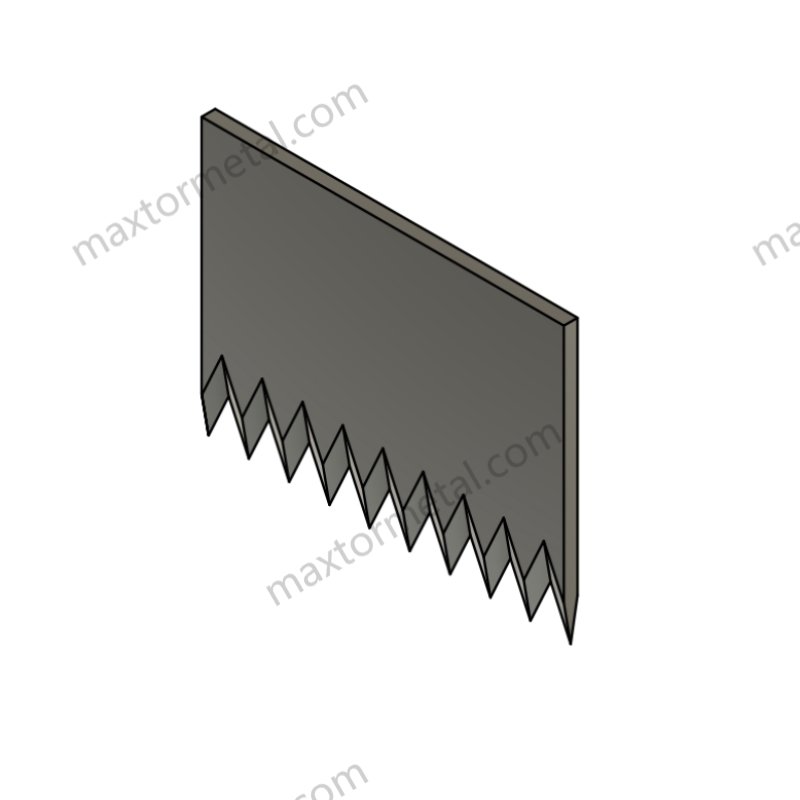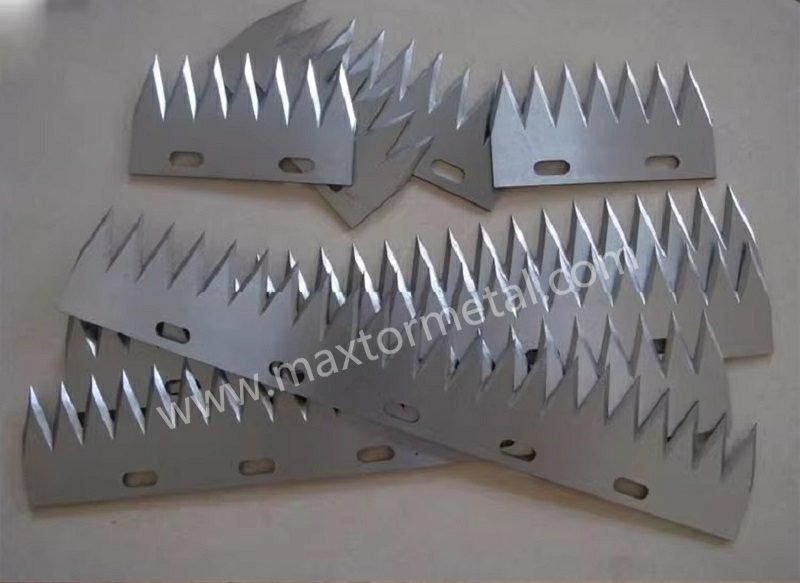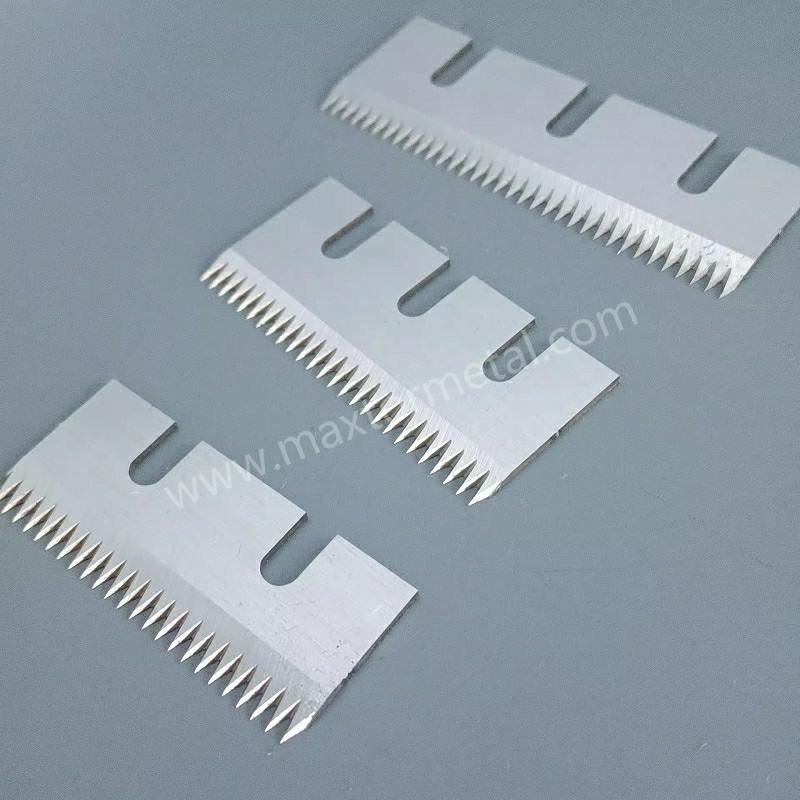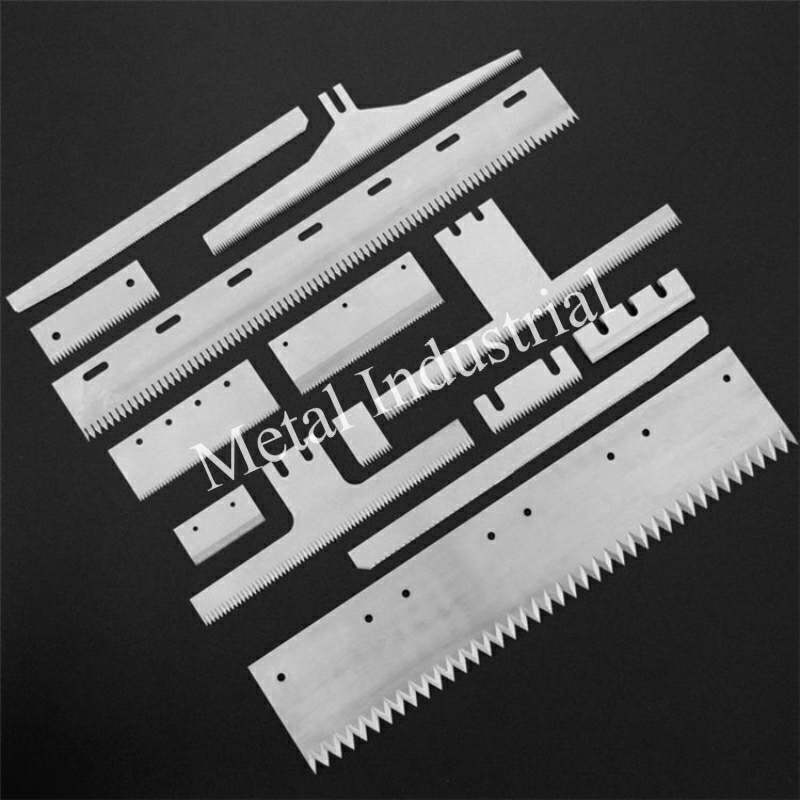
Lâminas para Embalagens são essenciais para cortar e selar materiais com eficácia. O mercado de lâminas flexográficas, que inclui essas lâminas de embalagem, é avaliado em $1,2 bilhões em 2023 e a previsão é de que cresça para $2,1 bilhões até 2032A manutenção adequada das lâminas, como limpeza e inspeções regulares, melhora seu desempenho, prolonga sua vida útil e reduz custos. Empresas como Nanquim Metal Especializamo-nos no fornecimento de lâminas personalizadas, adaptadas a requisitos específicos de embalagem. Manter as lâminas em condições ideais é crucial para garantir a segurança e o alto desempenho. Sinta-se sempre à vontade para Contato fornecedores confiáveis para assistência quando necessário.
Principais conclusões
- Verifique as lâminas da embalagem com frequência para detectar danos precocemente. Isso evita reparos caros e mantém as lâminas funcionando corretamente.
- Limpe as lâminas após o uso para remover sujeira e água. Isso as mantém afiadas e evita a formação de ferrugem.
- Aplique os óleos corretos nas suas lâminas para reduzir o atrito e prolongar sua vida útil. Uma boa lubrificação ajuda as lâminas a cortar com suavidade e facilidade.
Compreendendo as lâminas de embalagem
O que são lâminas de embalagem e seus outros nomes?
Lâminas de embalagem são ferramentas feitas para cortar embalagens. Também são chamadas de facas industriais, lâminas de corte ou lâminas de conversão. Essas lâminas cortam, aparam ou perfuram materiais como plástico, papel e papelão. Suas bordas afiadas e estrutura robusta as tornam muito úteis. São necessárias para cortes limpos e precisos em muitos setores. Conhecer sua finalidade ajuda você a entender como elas mantêm a eficiência e a alta qualidade das embalagens.
Como funcionam as lâminas de embalagem?
As lâminas de embalagem cortam materiais usando força controlada. Suas bordas afiadas tornam o corte suave e fácil. Algumas lâminas têm bordas serrilhadas para materiais resistentes, enquanto outras são retas para cortes precisos. A afiação, a posição e o tipo de material da lâmina afetam seu funcionamento. Cuidar das lâminas as mantém funcionando bem, economizando tempo e reduzindo o desperdício.
Onde as lâminas de embalagem são usadas?
Lâminas para embalagens são utilizadas em diversos setores. Na indústria alimentícia, elas cortam filmes para salgadinhos, congelados e bebidas. Em fábricas, elas cortam espuma, borracha e tecido. Até hospitais as utilizam para cortar embalagens estéreis. Essas lâminas são importantes para qualquer trabalho que exija precisão e rapidez. Escolhendo a lâmina certa ajuda a melhorar seu processo de trabalho.
Inspeções regulares e identificação de desgaste
Verificações regulares são essenciais para manter as lâminas em bom estado. Detectar o desgaste precocemente evita grandes reparos e mantém as lâminas funcionando bem. Esta seção mostra como encontrar desgaste, fazer verificações e por que os reparos precoces são importantes.
Reconhecendo padrões de desgaste
Sinais comuns de desgaste
As lâminas se desgastam com o uso constante ao longo do tempo. Você pode notar o desgaste pela forma como a lâmina corta. Uma lâmina cega pode deixar bordas ásperas ou irregulares. Mais atrito durante o corte é outro sinal. Sons estranhos ou trepidações também podem indicar desgaste. Observar esses sinais ajuda a corrigir problemas precocemente.
Técnicas de Inspeção Visual
Observar as lâminas atentamente ajuda a verificar seu estado. Use luz forte para ver o fio da lâmina com clareza. Procure por rachaduras, lascas ou pontos de ferrugem. Uma lupa ajuda a identificar pequenos danos. Gire a lâmina lentamente para encontrar dobras ou partes irregulares. Verificações regulares como essa mantêm as lâminas em bom estado.
Realização de verificações de rotina
Frequência das inspeções
A frequência com que você verifica as lâminas depende do uso delas. Para uso intenso, verifique diariamente ou semanalmente. Para uso mais leve, verificações mensais podem funcionar. Um cronograma definido ajuda a identificar problemas com antecedência e mantém o trabalho funcionando sem problemas.
Ferramentas para inspeções eficazes
As ferramentas certas facilitam a verificação das lâminas. Uma lupa mostra pequenas falhas. Uma régua verifica se a lâmina está reta. Um pano limpo pode encontrar ferrugem ao limpar a lâmina. Essas ferramentas tornam as inspeções simples e precisas.
Importância da detecção precoce
Benefícios de reparos oportunos
Corrigir problemas com as lâminas rapidamente traz muitos benefícios. Facilita o corte e reduz o desperdício de materiais. Correções antecipadas também evitam atrasos e mantêm o trabalho no caminho certo. Corrigir problemas com antecedência ajuda as lâminas a durarem mais e a funcionarem melhor.
Economia de custos com manutenção preventiva
Cuidar das lâminas economiza dinheiro ao longo do tempo. Consertar pequenos danos custa menos do que substituir uma lâmina. Inspeções regulares evitam substituições caras, detectando o desgaste precocemente. Lâminas bem cuidadas também consomem menos energia, reduzindo custos e melhorando a eficiência.
Limpeza e Prevenção de Ferrugem

Como manter suas facas limpas e secas
Mantendo facas Limpar e secar é muito importante. Durante o uso, as lâminas da embalagem acumulam sujeira, como pó de papel, cola ou pedaços de plástico. Estes podem grudar na lâmina e dificultar o corte. Para evitar isso, limpe as lâminas após cada uso. Use um pano macio para remover a sujeira solta. Para sujeiras pegajosas, use sabão neutro e uma esponja macia. Sempre seque bem as lâminas para evitar umidade, que causa ferrugem.
A água pode prejudicar seu lâminas. Guarde-as em local seco e longe do ar úmido. Se você trabalha em uma área úmida, use um desumidificador para proteger suas ferramentas. Estas etapas ajudam a mantê-las facas limpo e afiado por mais tempo.
Melhores práticas para limpeza de lâminas de embalagem
Limpeza Lâminas para Embalagens precisa de medidas cuidadosas para mantê-las funcionando corretamente. Se possível, retire a lâmina da máquina para limpá-la completamente. Use uma escova macia ou jato de ar para remover a sujeira. Para manchas pegajosas, use água morna com sabão neutro ou um limpador de lâminas especial. Não use produtos químicos fortes que possam danificar a lâmina.
Limpe sempre na direção do fio da lâmina para evitar que ela fique cega. Enxágue com água limpa e seque imediatamente com um pano sem fiapos. A limpeza frequente facilita o corte e aumenta a durabilidade das lâminas. Siga estas dicas:
- Limpe as lâminas após cada turno de trabalho.
- Verifique se há danos durante a limpeza.
- Use luvas para se manter seguro durante a limpeza.
Esses hábitos mantêm Lâminas para Embalagens forte e confiável.
Ferramentas e Soluções para Prevenção de Ferrugem
A ferrugem pode arruinar seu lâminas rapidamente. Para evitar a ferrugem, use óleo ou spray antiferrugem na lâmina. Esses produtos impedem que a umidade atinja a superfície. Para guardar as lâminas, use capas ou embrulhe-as em papel antiferrugem.
Use compressas de sílica gel ou desumidificadores para manter as áreas de armazenamento secas. Se aparecer ferrugem, limpe-a com um removedor de ferrugem ou palha de aço fina. Após remover a ferrugem, aplique óleo novamente para proteger a lâmina. A manutenção regular dessas ferramentas mantém lâminas sem ferrugem e pronto para uso.
Dica: Limpe as lâminas com frequência para remover sujeira e cola. Isso reduz o atrito e aumenta a durabilidade das lâminas.
Técnicas de Lubrificação
Por que a lubrificação é importante para a manutenção das lâminas
A lubrificação é fundamental para manter Lâminas para Embalagens funcionando bem. Reduz o atrito, tornando o corte mais suave e fácil. Sem ela, as lâminas podem esquentar demais, desgastar-se rapidamente ou quebrar. A lubrificação também previne a ferrugem e a corrosão, que enfraquecem as lâminas com o tempo. Lubrificar suas lâminas com frequência ajuda-as a durar mais e a funcionar melhor.
Dica: Verifique se a lâmina está seca ou áspera. Isso significa que precisa de óleo.
Escolhendo os melhores lubrificantes para lâminas de embalagem
Nem todo lubrificante funciona para Lâminas para EmbalagensEscolha um que seja adequado ao material da lâmina e à sua função. Para embalagens de alimentos, use óleos próprios para alimentos, de acordo com as normas de segurança. Para tarefas mais pesadas, escolha óleos industriais fortes ou sprays. Não use óleos domésticos comuns, pois podem danificar a lâmina ou não protegê-la.
Como aplicar lubrificantes corretamente
Usar lubrificantes da maneira correta os torna mais eficazes. Primeiro, limpe a lâmina para remover sujeira e poeira. Em seguida, aplique uma pequena quantidade de óleo uniformemente na lâmina. Use um pano macio para espalhar por toda a superfície. Não use muito óleo, pois ele pode acumular sujeira. Certifique-se de lubrificar as lâminas com frequência, especialmente após a limpeza ou uso intenso.
Observação: Mantenha os lubrificantes em um local fresco e seco para mantê-los frescos.
Afiação e manutenção de lâminas

Por que as lâminas de embalagem afiadas são importantes
Melhor desempenho de corte
Afiado Lâminas para Embalagens tornam o corte mais rápido e preciso. Lâminas cegas exigem mais esforço, retardando o trabalho e causando erros. Estudos mostram que lâminas afiadas economizam tempo e reduzem erros. Isso mantém as tarefas de embalagem suaves e confiáveis. Nas indústrias alimentícia e médica, lâminas afiadas garantem cortes limpos, melhorando a segurança e a qualidade do produto.
Menos desperdício de material
Lâminas cegas podem danificar os materiais, causando cortes irregulares. Por exemplo, bordas ásperas em plástico ou papel podem torná-los inutilizáveis. Manter as lâminas afiadas reduz o desperdício e economiza dinheiro. Lâminas de corte bem conservadas cortam com precisão, aumentando a produtividade. A afiação regular ajuda você a usar os materiais com eficiência, mantendo altos padrões de qualidade.
Sabendo quando afiar
Resultados de corte ruins
Se a sua lâmina tem dificuldade para cortar ou deixa bordas ásperas, ela está cega. Isso dificulta as tarefas e reduz a qualidade do trabalho. Observar esses sinais ajuda a afiar antes que os problemas se agravem.
Mais atrito durante o corte
Uma lâmina cega cria resistência e não desliza suavemente. Isso pode causar superaquecimento, danificando a lâmina ou o material. Sons ou vibrações estranhas também indicam que é hora de afiar.
Maneiras de afiar lâminas de embalagem
Afiação manual
Afiar manualmente é uma maneira confiável de manter as lâminas afiadas. Use uma pedra de amolar e segure a lâmina em um ângulo de 20 a 30 graus. Mova-a firmemente sobre a pedra em ambos os lados até que esteja afiada. Esse método leva tempo, mas oferece controle total.
Usando apontadores elétricos
Os afiadores elétricos são rápidos e fáceis de usar. Eles ajustam automaticamente o ângulo correto, ideal para iniciantes. Insira a lâmina e a máquina afia para você. Verifique se o seu tipo de lâmina é compatível com o afiador antes de usá-lo.
Ferramentas para afiar
Escolhendo a pedra certa
A pedra de afiar certa é fundamental para bons resultados. Pedras grossas consertam bordas danificadas, enquanto as finas dão polimento à lâmina. Pedras combinadas oferecem ambas as opções e são versáteis. Certifique-se de que a pedra seja adequada ao material da sua lâmina para evitar danos.
Outras ferramentas de afiação
Além das pedras, outras ferramentas podem ajudar. Afiadores de bancada são ótimos para reparos rápidos, e esmerilhadeiras de bancada lidam com trabalhos mais complexos. Afiadores com revestimento de diamante funcionam bem em lâminas duras. Escolha ferramentas que atendam às necessidades da sua lâmina para obter o melhor resultado.

Mantendo a lâmina afiada
Verifique a nitidez da lâmina com frequência
Após afiar, inspecione a lâmina regularmente para verificar se há cortes ou danos. Procure por bordas irregulares ou pequenos cortes. Verificações rápidas antes do uso economizam tempo e mantêm as lâminas funcionando perfeitamente.
Limpeza após afiação
Limpe as lâminas após afiá-las para remover os resíduos de metal. Limpe com um pano macio e aplique uma leve camada de óleo para evitar ferrugem. Evite produtos de limpeza agressivos que possam danificar a lâmina. A limpeza mantém as lâminas seguras e prontas para uso.
Dica: Guarde as lâminas em um local seco e seguro para proteger seu fio.
Uso e manuseio adequados
Manuseio seguro de lâminas de embalagem
Use equipamento de proteção
A segurança começa com o uso de equipamentos de proteção. Luvas Proteja as mãos de cortes e escorregões. Óculos de proteção protegem seus olhos de detritos voadores. Botas com biqueira de aço evitam ferimentos em caso de queda de algo pesado. Essas medidas tornam o local de trabalho mais seguro.
Você sabia? Em 2016, a Índia tinha 48.000 mortes no local de trabalho. Muitos envolveram ferramentas afiadas, mostrando por que a segurança é importante.
Use técnicas de pegada apropriadas
Segurar lâminas corretamente para se manter seguro. Segure a alça firmemente e mantenha os dedos afastados da borda. Use as duas mãos para materiais resistentes. Não empurre com muita força, pois pode causar escorregões. Boas técnicas de pegada melhoram o controle e reduzem acidentes.
Erros comuns a evitar
Posicionamento inadequado da lâmina
O posicionamento incorreto da lâmina pode causar acidentes. Sempre prenda a lâmina no suporte antes de usar. Lâminas soltas podem oscilar e cortar de forma irregular. Verifique a posição da lâmina antes de iniciar o trabalho para sua segurança.
Negligenciar os protocolos de segurança
Ignorar as regras de segurança é perigoso. Desligue as máquinas antes de consertar lâminas Para evitar ferimentos. Verifique se as lâminas estão afiadas ou danificadas para evitar falhas. Seguir as medidas de segurança mantém todos seguros e o trabalho tranquilo.
Lembrete importante: Em 2019, houve 15.380 casos de ferimentos por corte em fábricas nos EUA. Muitos poderiam ter sido evitados seguindo as normas de segurança.
Treinamento para Funcionários
Realizar sessões regulares de treinamento
O treinamento ajuda os trabalhadores a usar lâminas com segurança. Realize sessões frequentes para ensinar o manuseio e os cuidados adequados. Faça demonstrações para aumentar a confiança. O treinamento reduz acidentes e aumenta a eficiência.
Fornecer manuais de instruções claros
Os manuais de instruções são úteis para os trabalhadores. Forneça guias fáceis de ler sobre lâmina uso e cuidados. Inclua etapas, dicas de segurança e conselhos para solução de problemas. Uma equipe treinada cuida lâminas de forma responsável.
Melhores práticas para uso de lâminas
Siga as diretrizes do fabricante
Siga as instruções do fabricante para lâmina cuidado. Essas dicas melhoram o desempenho e a segurança. Algumas lâminas precisam de limpadores especiais ou métodos de afiação. Ignorar essas regras pode danificar o lâmina.
Desempenho da lâmina do monitor
Verifique o quão bem o lâmina funciona com frequência. Se tiver dificuldades ou cortar mal, afie-a ou substitua-a. Observar o desempenho economiza materiais e mantém os resultados consistentes.
Dica: Na Índia, 47 operários de fábrica se machucam diariamente por desrespeitarem as normas de segurança. lâmina o desempenho e as dicas a seguir podem prevenir lesões.

Melhores práticas de armazenamento
Armazenando Lâminas para Embalagens Mantém-nas afiadas, sem ferrugem e seguras. Siga estas dicas para fazer com que suas lâminas durem mais e permaneçam em ótimo estado.
Condições ideais de armazenamento
Mantenha a área seca
A umidade é ruim para lâminas. Causa ferrugem, tornando-os fracos e menos eficazes. Um ambiente seco é importante. Mantenha a umidade abaixo de 50% para retardar a ferrugem. Por exemplo:
| Nível de umidade (%) | Tempo antes da formação de ferrugem (lâminas de aço desprotegidas) |
|---|---|
| 30% (Ambiente Seco) | 2–4 semanas |
| 50% (Umidade Moderada) | 5–7 dias |
| 70% (Alta Umidade) | 48 horas |
| 90%+ (Umidade Extrema) | 12 horas |
Use compressas de sílica gel ou desumidificadores para absorver a umidade. Essas ferramentas ajudam a proteger seu lâminas da ferrugem.
Controle a temperatura
Grandes mudanças de temperatura podem causar a formação de água lâminas. Isso leva à ferrugem. Armazene lâminas em local fresco e estável entre 60°F e 75°F. Evite fontes de calor, pois podem entortar ou danificar o lâminas.
Dica: Use um termômetro e um higrômetro para verificar as condições de armazenamento.
Organizando lâminas de embalagem
Use porta-lâminas
Os porta-lâminas mantêm lâminas Seguros e organizados. Eles evitam arranhões e danos. Os porta-palhetas são feitos de materiais macios. Prateleiras de parede ou gavetas são ótimas para armazenar muitos lâminas ordenadamente.
Espaços de armazenamento de etiquetas
As etiquetas facilitam a localização do produto certo lâminaMarque os slots ou suportes com o tipo ou tamanho da lâmina. Isso economiza tempo e evita erros. O armazenamento organizado aumenta a eficiência em até 30%.
Você sabia? Uma boa organização reduz o tempo e os erros no manuseio das lâminas.
Prevenção de danos
Proteger da luz solar
A luz solar pode aquecer lâminas irregularmente, causando deformações ou desbotamento. Os raios UV também danificam os revestimentos protetores, levando à ferrugem. Armazene lâminas em áreas sombreadas ou cobertas para evitar danos causados pelo sol.
Mantenha as lâminas secas
A água é prejudicial para lâminas. Mesmo pequenas quantidades podem causar ferrugem. Não armazene lâminas perto de pias ou canos. Se a área estiver úmida, use inibidores de corrosão por vapor (VCI) para bloquear a umidade.
Dica profissional: Adicione uma fina camada de óleo antiferrugem antes de armazenar lâminas para proteção extra.
Verificações regulares da lâmina
Procure por ferrugem
Verificar armazenado lâminas frequentemente para ferrugem. A ferrugem aparece como manchas, áreas ásperas ou descoloração. Limpe a ferrugem com um apagador de ferrugem ou palha de aço fina. Após a limpeza, aplique óleo para proteger a lâmina.
Teste de nitidez
Mesmo sem uso lâminas pode ficar cego se armazenado de forma inadequada. Teste a nitidez cortando algo simples. Se o corte não for suave, afie a lâmina. Verificações regulares mantêm lâminas pronto para uso.
Lembrete: Inspecionar armazenado lâminas todo mês para detectar problemas precocemente e mantê-los em ótimas condições.

Os benefícios das lâminas personalizadas
O que são lâminas personalizadas?
Lâminas Personalizadas são ferramentas especiais feitas para tarefas específicas de embalagem. Ao contrário das lâminas comuns, elas são projetadas para determinados materiais, máquinas ou métodos de corte. Essas lâminas ajudam a tornar a embalagem mais precisa e eficiente. Uma empresa confiável como Nanquim Metal cria lâminas personalizadas para atender perfeitamente às suas necessidades. Com 18 anos de experiência, a Nanjing Metal é conhecida por fabricar lâminas industriais de alta qualidade. Sua equipe de especialistas garante que cada lâmina atenda aos altos padrões e às necessidades dos clientes.
Vantagens das lâminas personalizadas para necessidades de embalagem
Lâminas personalizadas trazem muitos benefícios ao trabalho de embalagem. Primeiro, elas cortam com mais precisão, reduzindo o desperdício e proporcionando resultados limpos. Segundo, elas economizam tempo, pois exigem menos substituições ou ajustes. Terceiro, elas protegem suas máquinas, causando menos desgaste. Por exemplo, empresas que utilizam lâminas personalizadas observaram as seguintes melhorias:
| Título do estudo de caso | Principais vantagens |
|---|---|
| Reduzir por meio do redesenho | Economizou dinheiro e materiais para serviços de satélite. |
| Eficiência aumentada | Eficiência aumentada para um fornecedor global de embalagens $1B. |
| Redução de Danos | Redução de danos em servidores blade durante o transporte para uma empresa global. |
| Custo de frete reduzido | Reduza os custos de envio para um grande distribuidor de cosméticos. |
Esses exemplos mostram como lâminas personalizadas podem economizar tempo, reduzir custos e melhorar resultados.
Quando investir em lâminas personalizadas
Opte por lâminas personalizadas quando as comuns não funcionarem bem. Se você lida com materiais especiais, precisa de cortes precisos ou troca as lâminas com frequência, as lâminas personalizadas são a solução. Elas também são ótimas para indústrias que exigem segurança ou limpeza rigorosas, como embalagens alimentícias ou médicas. Trabalhar com especialistas como a Nanjing Metal garante que você tenha lâminas feitas sob medida para as suas necessidades. Suas habilidades ajudam a melhorar o desempenho e economizar dinheiro ao longo do tempo.
Quer melhorar seu processo de embalagem? Entre em contato com a equipe da Nanjing Metal hoje para saber mais sobre lâminas personalizadas.
Cuidar das lâminas de embalagem garante seu bom funcionamento e segurança. Limpe, afie e armazene-as adequadamente para que durem mais. Trabalhar com um fabricante de lâminas confiável como a Nanjing Metal garante alta qualidade e opções personalizadas. Confira a competência deles agora mesmo. 👉 Entre em contato com a equipe para aprimorar seu trabalho de embalagem.
Perguntas frequentes
Com que frequência você deve limpar as lâminas da embalagem?
Limpe as lâminas após cada uso. Isso evita o acúmulo de sujeira. Também reduz o atrito e ajuda as lâminas a durarem mais. Sempre seque-as bem para evitar ferrugem.
Quais ferramentas são melhores para afiar lâminas de embalagem?
Pedras de amolar proporcionam resultados precisos. Afiadores elétricos são mais rápidos. Use hastes de amolar para soluções rápidas. Escolha ferramentas que combinem com o tipo de lâmina.
As lâminas podem ser armazenadas em locais úmidos?
Não guarde as lâminas em locais úmidos. A umidade as enferruja e as enfraquece. Use compressas de sílica gel ou desumidificadores para manter o local de armazenamento seco.
Veja também
Soluções de corte eficazes para materiais pegajosos: evite danos à lâmina e melhore o desempenho



3 respostas